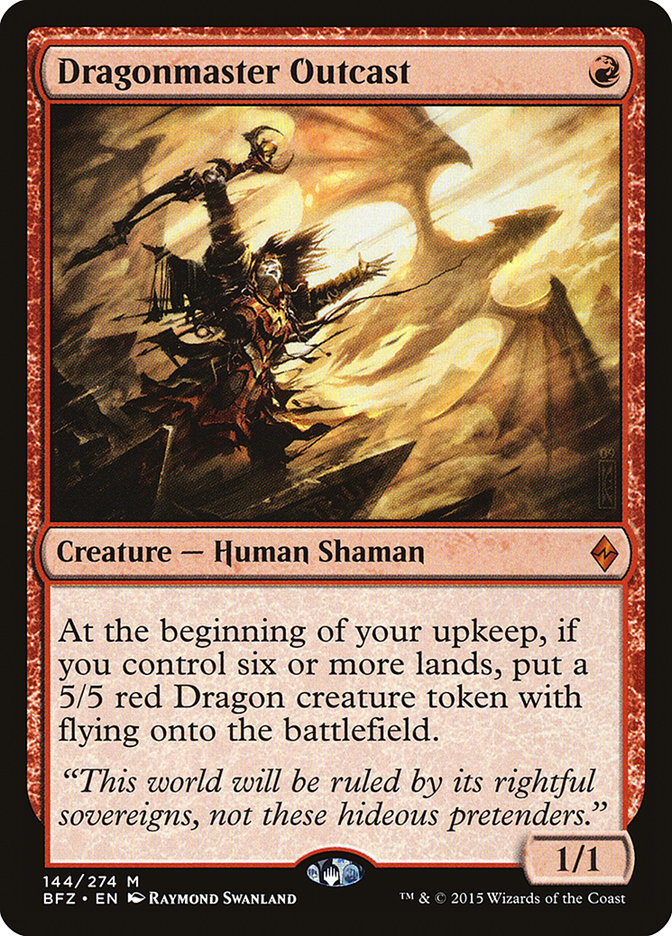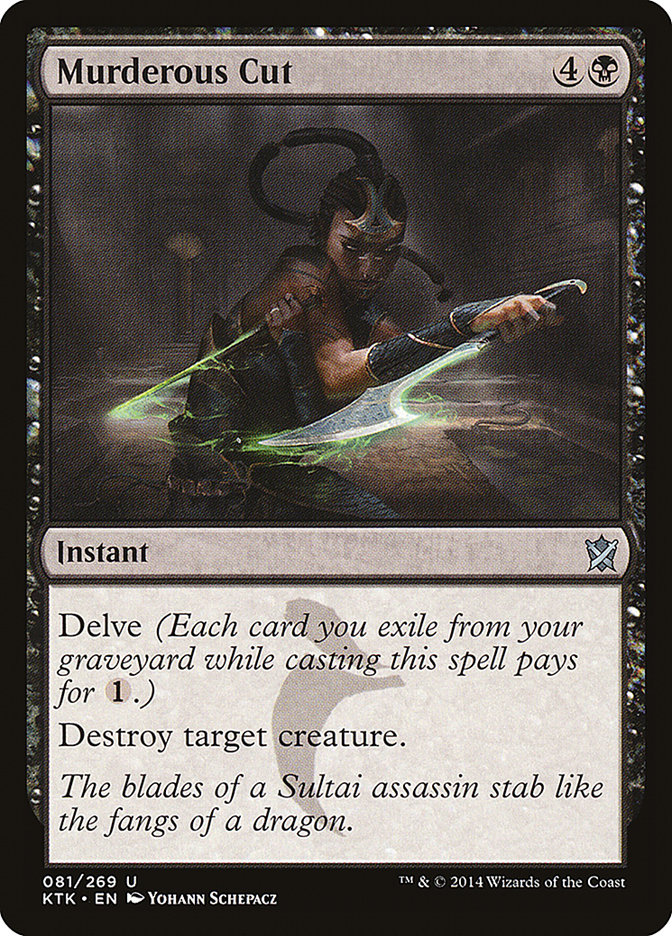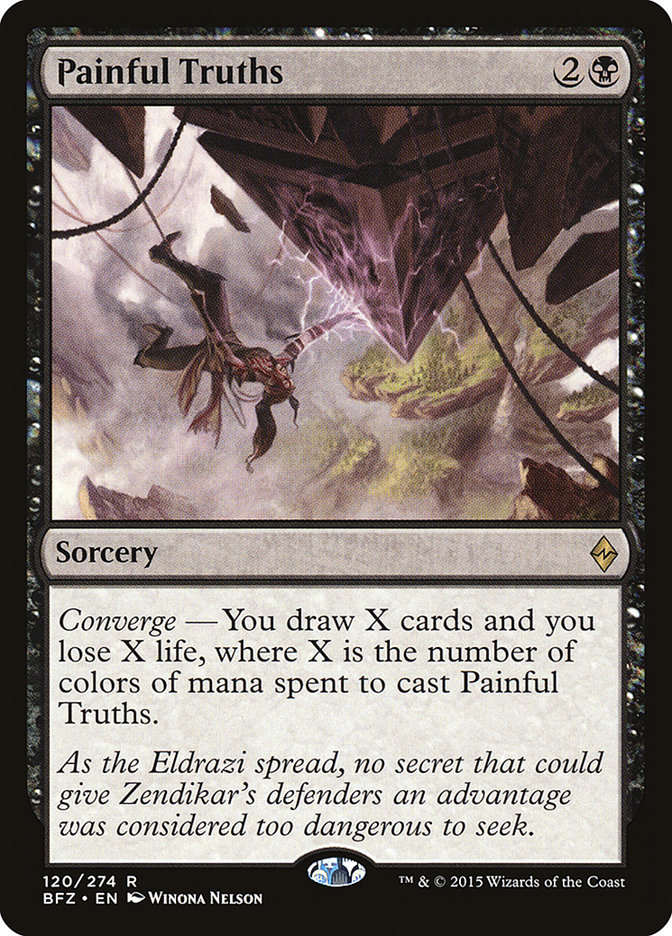I haven’t written a lot lately. I’m not exactly sure why. It could be that I’m lazy, and making Magic Online videos is a bit easier and less time consuming. It could be that I don’t want to bother saying the same thing about Jeskai Black for the third week in a row. But more than likely, it’s that I can’t find my voice. Even now, I’ve written and deleted this same paragraph three times. Each time I try to convey exactly what I’m feeling, with very little luck. I guess this time, I’ll just leave it as-is and see where I go after that. Writer’s block is pretty hard to break, and most of the time it takes just writing down your thoughts and seeing where things go from there.
I’m sitting here in Las Vegas, wondering what I’m really doing with my life. On the surface, things are pretty great. I get to play Magic for a living and write about it in the hopes of making someone else a little better at this great game. But under that surface, I’m afraid. This race towards the #SCGPC has been incredibly close and stressful. Week in and week out the pressure to continually put up results has been taxing, both mentally and physically. Each weekend makes me feel farther and farther away from home, to the point where I just want to give up.
The Grind
The hamster wheel we’re put through, week in and week out, is nauseating. At this point, even Magic Online is changing to reward people for constant, year-long play. With the Grand Prix/Pro Tour Circuit, the Open Series Circuit, and now the Magic Online Championship Series “Circuit,” it all boils down to just choosing one and sticking to it. Earlier in the year, I wanted to push for the Pro Tour. I went to a few extra Grand Prix that I wouldn’t normally go to, but my results from this last Pro Tour Season were about as impressive as they’ve been throughout the majority of my career: mediocre. A Top 75 finish was not enough to get me qualified for another one, and I honestly don’t have the time or energy to play PPTQs, culminating in a one-shot tournament to make it to the Pro Tour.
I made my choice in October: a push for the #SCGPC. With the way the IQ system was a part of the process, it meant that some players in the northeastern region of the United States could feasibly play five tournaments per week, all gaining Open Series Points. While this is changing for next year, it doesn’t make it any less stressful for where I’m at now. At the moment, I feel like I’m mostly safe to qualify for the #SCGPC, but some crazy things can still happen at the #SCGINVI in Las Vegas this weekend. Tom Ross is currently the last person qualified, with Logan Mize and myself dead even in the slot right above him. Eric Hawkins and a few others could potentially pass Tom or myself if we fail to make the second day of play at the #SCGINVI, and they put up a great finish.
But if it wasn’t for me making my sixth Open Series Top 8 this year, winning one of the State Championships, and winning one of the Regional Championships, I wouldn’t even have a shot. Chris Andersen deserves a lot of credit. He’s been annihilating the Open Series this year, but is still on the outside looking in as far as the #SCGPC is concerned. He started just a little too late, and didn’t reside in a region that catered to the IQ schedule he needed to get enough points to make the cut. Of course, he’s not mathematically eliminated, and could still win the whole shebang this weekend and qualify that way, but three people with the best results in the Open Series this year (myself, Chrandersen, and Tom Ross) are all close to the bottom.
I’m not complaining. If anything, I’m just adding to the sweat that the structure of the system has put on the players. We’ve been through a lot this year trying to qualify for the #SCGPC, with all of the competitors blowing last year’s point leaders out of the water. Each week, we know exactly what we need to do in order to keep up in the race, or pass the next person. We know how many points it takes to be safe, and how many points every single other competitor is getting. We’re keeping up with it, just like many of you at home, and that adds to the drama as we wrap up this year of Magic.
But I will be so friggin’ happy when we’re done and finally get to take a break. The hamster can only run on the wheel for so long before he needs a breather.
The End of the Line
This weekend will be a very important one for the #SCGPC race, with a multi-format tournament featuring both Modern and Standard. The #SCGINVI in Las Vegas will give out a lot of Open Series points as well as a ton of money and a chance to get your likeness on a token. Will I be the victor? Likely not, but I’m going to try my best to get my face on a Dragon token. Dragonmaster Outcast and I have become very close friends as of late.
It is no secret that I’ve been a huge advocate for Jeskai Black over the last few months, and you would think that I’d get sick of playing the same deck week after week. Well, I am just as surprised as you to hear that I am not sick of it. In fact, I have so much fun playing Jeskai Black that it is likely hurting my chances of winning tournaments, even though my results have been quite good with the archetype.
There is just something enticing about having nearly every spell in your deck act as a two-for-one, even if those cards don’t always do exactly what you need them to do. But what Jeskai Black lacks in pure power level, it more than makes up for in having the tools to get the job done, one way or another. Some games are won on the back of a Jace emblem. Others are won by rebuying Crackling Doom over and over with Soulfire Grand Master. Others still are won by your opponent conceding out of sheer frustration. Truly, this is a great time to be alive.
For weeks, I swore off Mantis Rider in favor of leaning towards a more controlling version of Jeskai Black. A lot of people have commented that Mantis Rider is too good to cut, and I must be a crazy person. Well, who’s got the chips? The answer: the two guys who beat me in the Top 8 each time. Mantis Rider and Tasigur out of Jeskai Black allow you to close games quickly when the opponent stumbles, which is not something my version(s) of Jeskai Black are able to do. If you watched the quarterfinals of #SCGDEN last weekend, Joe Lossett missed multiple land drops and was missing black mana for quite a few turns, and I just wasn’t able to kill him before he caught back up. And since his deck has a lot more built-in card advantage than mine, he was able to eventually out-resource me, even though I was very far ahead in the early turns of the game.
I could have played differently to give myself a better chance of winning, but Joe’s Five-Color Bring to Light deck had a lot of powerful spells on top of potent card advantage, which ultimately pushed me out of both games I lost. While I did flood a bit in both games, I think it would have been very hard for me to win a game that goes on for more than ten turns or so.
But while my Jeskai Black deck had some flaws this past weekend, I think I’m going to be able to plug those holes before the #SCGINVI. I’ve got some ideas to help out in the places where I thought the deck was lacking, but for the most part it felt great.
For those of you who didn’t know, my version was based on the “Moist Mardu” deck by Michael Majors.
Creatures (9)
Lands (26)
Spells (25)

Creatures (9)
Lands (26)
Spells (25)
- 2 Duress
- 4 Crackling Doom
- 2 Utter End
- 2 Murderous Cut
- 2 Treasure Cruise
- 3 Ojutai's Command
- 2 Roast
- 2 Kolaghan's Command
- 4 Fiery Impulse
- 2 Painful Truths
Sideboard

As you can see, Majors made a major impact on how I built my Jeskai Black deck. While I’ve been playing the archetype with four copies of Dig Through Time for weeks now, I’ve wondered if Treasure Cruise (or something similar) might be better. Raw card advantage is generally better in controlling strategies that want to hit all of their land drops. So that was the question: did I want to hit all of my land drops?
With four copies of Soulfire Grand Master in the deck, you actually make a lot of matchups much easier. Gaining a healthy amount of life in the early turns of the game ensures that you’ll be able to find your big draw spells and eventually gain control of the game. Without a way to gain some life, you could find yourself staring down the wrong end of a Siege Rhino. But when you have a Soulfire Grand Master going, the buffer you create between your opponent’s creatures and your life total can be staggering. Just ask anyone who’s ever played Atarka Red and faced off against a Soulfire Grand Master. Things get out of hand quickly.
The ability to constantly recur both Jace and Soulfire Grand Master via Kolaghan’s Command and Ojutai’s Command is also pretty busted. Even if they kill the first copy, that doesn’t mean it won’t come back and eventually kill them. In actuality, they’re on a clock, because if they can’t kill you before you get your engine up and running, it will be almost impossible for them to kill you afterwards.
The real missing piece, which I’ve actually had in the deck before, was Murderous Cut. A cheap answer to virtually any creature in Standard, Murderous Cut is only limited by how many delve spells you play. And with four copies of Dig Through Time, Murderous Cut just didn’t make it into the fold. But with four copies of Soulfire Grand Master in the deck, you can afford to play some number of Painful Truths in the maindeck as opposed to delve spells that draw cards. Majors and I disagree on how many Painful Truths is correct, but I don’t think you can afford to play four of them with Atarka Red being one of the better decks in Standard. It is too much of a liability.
Two is certainly fine, but that forces you to make some small changes. The deck can easily support four and maybe even five delve spells with so much cheap removal and various ways to fill your graveyard. As a result, I think that something like two Murderous Cut and two Treasure Cruise gives you the best of both worlds. But honestly, I’m not a hundred percent on Murderous Cut even being necessary. Cheap removal is great with Soulfire Grand Master, which is the main draw for a spell like Murderous Cut in Jeskai Black, so it might be tough to argue cutting a card that I haven’t really gotten a feel for yet. It was rarely a bad card to draw, which I suppose should give it some merit.
What I’m really focused on “fixing” at the moment is the sideboard. I want more draw spells. I want more cards against Atarka Red. I want a few more cards that obliterate the opposition once I get far enough ahead. Unfortunately, we don’t have something like Cruel Ultimatum at our disposal, but some sort of engine would be good. I liked Majors’ Dark Petition idea, allowing you to play a few bullets for various matchups, and I will likely move in that direction for the #SCGINVI. There has been a huge decline in Eldrazi Ramp strategies, meaning the time of three Infinite Obliterations should come to a close. A single copy, along with one or maybe two Dark Petition, could be enough to get the job done. Tapping out against ramp isn’t something I want to do, but it might be necessary in order to have a more fluid sideboard against the rest of the field.
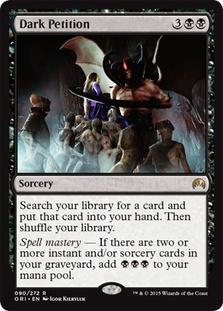
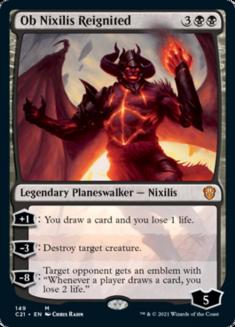
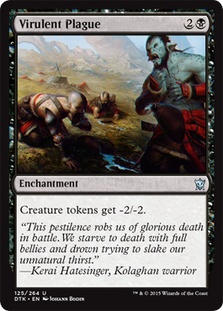
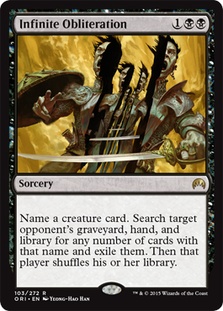
Outside of that change, the Erase (and Felidar Cub) is likely a thing of the past. Some decks will have enchantments you want to kill, like Silkwrap and Stasis Snare, alongside some troublesome enchantments, like Mastery of the Unseen, but a few copies of Utter End should be fine, and I haven’t been all that worried about my creatures dying before. I’m curious what cutting the Erase will do to my overall win percentage. My guess is very little one way or another, but it mostly depends on what card fills that slot. If it is a high-impact singleton, or perhaps an additional Radiant Flames or Arashin Cleric to help out against Atarka Red, the effect could be tremendous.
The next two days will be extremely important in helping me come up with the right configuration for the deck. The current list feels pretty close to what I want to be doing, but I had a lot of dead weight due to the fear of Eldrazi Ramp. While I did play against it quite a few times over the last few weeks, I should have realized that it has taken a downward swing in popularity. And with Atarka Red on the rise, I feel like that gap will only increase.
As for Modern, I’ll be honest: I have no idea what the right deck to play is. The format has so many variables that I feel like it is impossible to “solve,” and the correct choice is to just play whatever I’m comfortable with. I’m traditionally biased towards Splinter Twin and Snapcaster Mage decks, but my recent success has come with Infect. I’m not certain what I’ll play yet, and the time to make that choice is closing quickly. I do like the Grixis deck that has been gaining popularity, another Michael Majors special, but I don’t know if it has all the tools to compete against such a wide field.
In Modern, I think it is important to play a deck that can “take out the trash.” With so many fringe strategies just waiting in the wings to take you out, you want to have access to some sort of combo that can end the game on the spot. Since Splinter Twin takes up so few slots in a given deck, it is usually the go-to combo for control decks. It is no wonder that it has been around for so long and performed so well in various iterations. The Splinter Twin kill is almost a freeroll.
With so much on the line at the #SCGINVI this weekend, the pressure is high. The matches between the players on the leaderboard will have significant consequences on the finalized lineup for the #SCGPC. It will be a great tournament to watch, for multiple reasons, and I’m just hoping I scrape together a good enough finish to close out the season strong. I’m confident in my Standard deck, confident in my play in Modern, and have a reasonable lead on the people sitting behind me in the race. Let’s see if we can hold one time, sweetness.


